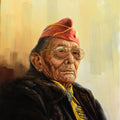Rahim Fortune's Photographs Defy Categorization
By Chadd Scott on
Photographer Rahim Fortune (b. 1994) demonstrates the futility of categorization. In multi-cultural contemporary America and the art world.
African American father. Native American mother. He’s an enrolled member of Chickasaw Nation. He split time growing up between Oklahoma and Texas. He considers home the 7-hour stretch of Interstate 35 between the Texas Hill Country around Austin and Oklahoma City. He lives in Round Rock, TX, but splits his time between there and New York City, where he went to college.
He shoots the Black rodeo and Black cowboys. Does that make him a Western artist? The Black rodeos he began shooting took place in Mississippi.
In addition to young bull riders, he also photographs African American praise dancers and pageant queens, depicting important communal and coming of age rituals.
So, is he a Black artist? Native artist? Southern artist? Western artist?
“I’m just one person made up of multiple things,” Fortune said.
Fortune’s multiplicity is on view through May 24, 2025, at Howard Greenberg Gallery in New York – arguably the nation’s most prestigious gallery for fine art photography – in a collaboration with Sasha Wolf Projects, “Rahim Fortune: Reflections.” The presentation features documentary photography reflecting Fortune’s personal history and his expression of compassion for the region that has nourished him personally and creatively.

Rahim Fortune, 'Untitled Cowboy (Acres Homes) Houston Texas,' 2023. Copyright Rahim Fortune, courtesy Sasha Wolf Projects and Howard Greenberg Gallery.
“Reflections” features two distinct series – “Hardtack” and “I Can’t Stand To See You Cry” – with 30 photographs and an untitled 2021 film.
In “Hardtack,” Fortune uses sites of historical and cultural significance as guides, illustrating the profound connections binding modern Black communities to their regions amid both adversity and joy. The bull riders appear in “Hardtack.”
“I Can’t Stand To See You Cry” explores Texas, the surrounding states, and the people fixed within its complex landscape. The series takes its name from an old school soul ballad of the same title.
“That song encapsulated a feeling of what I felt around the loss of my father and the passing of his generation,” Fortune explained. “Seeing my grandmother grieve her son passing away – my father – there was something that I learned about life in all of that. That was worth something within all the grief. I was able to see, ‘wow,’ what a thing to understand about mortality and life that I was able to witness and experience.”
A photo of Fortune’s grandmother appears in the show. She is Black and Indigenous.
“You can see her hair,” Fortune said. “It’s gray and it shows both her Black and Native roots.”
With this subject, Fortune’s photographs enter one of the prickliest subjects in the long and prickly intersection of race and politics in American history: Black Indigeneity.

Rahim Fortune, ‘Smoking Cowboy, Cheek, Texas,’ 2023, from the series ‘Hardtack.’ Silver gelatin print, 24 x 20 inches. Copyright Rahim Fortune, courtesy Sasha Wolf Projects and Howard Greenberg Gallery.
Here goes.
“The Five Civilized Tribes were deeply committed to slavery,” museum curator Paul Chaat Smith (Comanche) said in 2018 on the occasion of the opening of an exhibition he produced examining the connections between the Cherokee, Chickasaw, Choctaw, Creek and Seminole – the so-called Five Civilized Tribes – and their enslavement of Black people.
Remember, prior to the tribes forced removal by the U.S. government in the 1830s, 40s, and 50s – the Trail of Tears – these Nations occupied traditional lands within the Southeast – Mississippi, Tennessee, Georgia, Alabama, Florida – the seat of plantation slavery. Enslaved people followed their Indigenous “owners” on the Trail of Tears to reservations in “Indian Territory,” today’s Oklahoma.
Following removal and then emancipation, African Americans continued living among Native people. These Freedmen, even when marrying Native women and producing families, never had the same rights within Native nations. Nor did their descendants.
“It’s a touchy thing, especially in the realms of Afro Indigeneity and the lack of representation in the Native community, who really only want to accept registered members,” Fortune said. “It’s a very political thing. That’s why I don’t play (my Indigeneity) up in my work and story. My work is already so much about that, that me personally, I don’t need to pretend to be more virtuous. I try not to get into the jargon or the grift of it because I think that downplays the seriousness and the agency of the work.”
Well said.
The mixed African, African American and Indigenous side of Fortune’s family, his father’s side, doesn’t have the same claim to tribal citizenship as the directly descended from Chickasaw Nation mother’s side of his family does. One of Fortune’s great-grandmothers on his mother’s side was forcibly removed from Mississippi to Oklahoma. That side of the family has carefully documented and guarded its genealogy to assure tribal citizenship. That side of the family is registered Chickasaw and has the paperwork to prove it, including Dawes Rolls verification.
“My granny kept it in a hat box,” Fortune, who identifies as Afro-Indigenous remembers.
Without going too far down a rabbit hole of how the U.S. government encouraged Native people to turn on their own through purity tests and blood quantum, suffice to say, the topic is charged with passionate feelings on all sides.
Anyone interested in the subject wanting to learn more can begin with the linked episode of the exceptional, Native woman hosted podcast, “All My Relations.”

Rahim Fortune, ‘Hw290 Cowboys, Houston, Texas.’ Copyright Rahim Fortune, courtesy Sasha Wolf Projects and Howard Greenberg Gallery.
‘The Universals of People’
Fortune grew up a skateboard, punk rock, guitar kid carrying around a 35mm camera. His introduction to high end, fine art photography came through a teenage job at a photo lab where he met Austin-based photographer Eli Reed (b. 1946). Astonishing.
Reed was a Magnum photographer; the first Black Magnum photographer. The Magnum Agency is the world’s most prestigious photographic agency, a cooperative of photographers from around the world formed in 1947. Legendary Henri Cartier-Bresson was one of its co-founders.
Reed became an important and widely published documentary photographer in the 70s, 80s, and 90s, shooting around the globe, highlighting the struggles of the poor and oppressed. He’s produced numerous photobooks.
Meeting Reed encouraged Fortune to believe a career in photography was possible and began a journey that led him to New York. There, he met fellow photographer June Canado who had been working in the City and helped him navigate the landscape. He became exposed to edgier photobooks by the likes of Jim Goldberg and Mike Brody, the “grittier side of photography,” in his words.
“(It) opened my eyes to what photography could make you feel,” Fortune said.
The artist began shooting African American rituals and celebrations in Texas with the Juneteenth pageant and parade in Austin, a celebration of Black American freedom with roots in Galveston. Juneteenth, June 19th, is the day enslaved people in Galveston were finally freed by Union troops in 1965. The Emancipation Proclamation took effect in the North on January 1, 1963, but without anyone to enforce it in the South, slavery persisted. The last of America’s enslaved were freed in Galveston a full two-and-a-half years after the Emancipation Proclamation.
These rituals and ceremonies and celebrations – pageants, parades, rodeos, football games, church services – are a way the Black community in Texas stays connected. Activities Fortune continues participating in.
“That awareness to self-consciousness, to pride, ultimately, is a part of the vision of why I’m so interested in the depictions of culture,” Fortune said.
As for the Black rodeo and Black cowboy pictures, Fortune treads lightly.
“I approach the subject matter with a lot of criticality because I don’t want to over exploit the visuality of it,” he said. “I don’t have a ton of cowboy photos. The ones I do have I hope are impactful, strong ass photographs and are as much a statement as they are a representation of ‘X’ thing happening.”
They are.
Without screaming it, Fortune’s rodeo and cowboy pictures are a defiant reminder that the Yankee Doodle Dandy, John Wayne, whites only version of rodeo, cowboys, Texas and the West promoted in the 20th century has always been a lie. Depictions of African American and Mexican cowboys have finally broken through in mainstream Western art as well.
Fortune doesn’t consider his pictures “Western,” however.
“To me, the photos are a bit more Southern in that they are taken a lot in east Texas, Houston, which to me resembles the Louisiana influence and the more Black Belt influence of that part of Texas, especially what was known as the Cotton Highway,” he said.
Mirroring Fortune’s uncategorizable background, the West and Western art mean different things to different people.
“My photographs, in a way, are selfish, because I like to see (the pictures I shoot),” he said. “I don’t create overtly with the audience in mind. It’s more something I’m chasing that’s drawn by the lineage of image makers and influences, a lot of them having a deep culture in Texas.”
As a student of photography, Fortune hopes his work sparks new ideas more than changing anyone’s opinion.
“To me, as Walker Evans would say, that’s the job of propaganda,” Fortune said. “What I love is for people to interact with the photographs and feel inspired to learn about my story and perhaps look at the value within their own life. That is the universal humility of photography. One of the things I love about photography is it’s so much about human nature and the universals of people.”
The universals of people. The attributes we all share, not the categories separating us.



